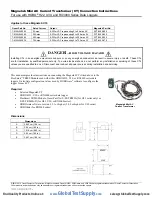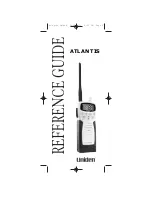
05-3946A01, Rev. C
TransNET OEM Integration Guide
27
It is important to note that power consumption will increase somewhat as
communication from the Master station degrades. This is because the radio
will spend a greater period of time “awake” looking for synchronization
messages from the Master radio.
In order for the radio to be controlled by Pin 4, the unit’s Sleep Mode must be
enabled through the
SLEEP [ON, OFF]
command. See
for more information.
NOTE:
If
INTRUSIVE
polling is used in InSite NMS software, it is necessary to select
SLEEP
MODE INHIBIT ON
from the
Polling Options
menu, on the
Network Wide Diag-
nostic Polling
screen.
Sleep Mode Example
The following example describes Sleep Mode implementation in a typical
system. Using this information, you should be able to configure a system that
meets your own particular needs.
Suppose you need communications to each Remote site only once per hour.
Program the RTU to raise an EIA/RS-232 line once each hour (DTR for
example) and wait for a poll and response before lowering it again. Connect
this line to Pin 4 of the radio’s
DATA
connector. This will allow each RTU to
be polled once per hour, with a dramatic reduction in power consumption.
6.7 Low-Power Mode (LPM)—Master Enabled
The Low-Power Mode (LPM) puts Remote radios into a configuration similar
to Sleep, but with some important distinctions. The most important difference
is that the radio will automatically go to sleep in this mode, regardless of the
condition of Pin 4 of the
DATA
interface connector.
This feature trades increased latency to gain power savings. The low-power
mode (LPM) automatically saves power at a Remote by instructing the
Remote to shutdown for long periods of time between SYNC messages.
Master transmissions are automatically blocked while the Remotes are
asleep. Note, both Masters and Remotes are adaptive and will suppress a
normal sleep interval until after the end of a current data transmission or
reception.
Setup Commands
These are the command options and their applications:
•
LPM 1
at the Master enables low-power mode network-wide; all
Remotes pick it up and start saving power by automatically sleeping.
LPM 1
can work in conjunction with the AT dialing feature. The dialed
unit will be forced awake; all others will sleep.
•
LPM 0
at the Master is used to disable low-power mode (LPM)
(Default setting following an
INIT
or firmware upgrade.)
For
LPMHOLD 0
with
REPEAT 0
setting, a Remote with no data to send will
consume about 1/4 of its normal power consumption. Note that the
SLEEP
command must be enabled for the LPM to function.
















































